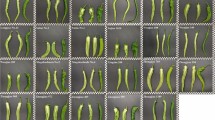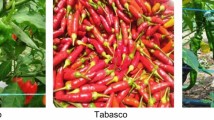Abstract
Chilli pepper is a widely spread vegetable crop and one of the main spices used all over the world. Its properties comprise high antioxidant capacity and content of several healthy-related compounds including vitamin C, carotenoids and capsaicinoids. In countries of the Mediterranean basin, chilli production is largely based on local varieties traditionally selected for open field conditions, although, the genetic improvement is a rapidly growing sector toward the development of hybrids. In the present study, nine chilli pepper varieties with diverse market destinations including powder consumption, canned production, and blister packaging as well as seven hybrids obtained through half-diallel crosses between the parent varieties were grown in replicated field trials over diverse locations and evaluated in a comprehensive approach regarding twenty-six quantitative agronomic, morphological and health-related phytochemical traits. Significant differences between hybrids and parents were found for 12 out of the 26 traits studied in both environments. Agronomic and chemical traits did not differ significantly except than for total yield and pH. Several biochemical traits differed significantly and carotenoids and ascorbic acid values were mostly linked to the cultivation environment. A significant effect of the genotype (P < 0.01) was found in all traits for both parental lines and hybrids. The phenotypic plasticity revealed high stability for fruit morphological traits in both parents and hybrids. Greater plasticity was found for total yield in the parent lines, while hybrids were more stable for capsaicinoids and more plastic for carotenoids and AsA, compared to parental. Significant mid-parent heterosis was observed in all the hybrids tested for at least one of the trait evaluated. The PCA in the first two dimensions explained 48.26% of the total variance showing a distinction between each hybrid and the related parental lines for the traits analyzed. This comprehensive approach used, allow to dissect those traits which can be successfully introgressed in hybrids and are useful for precision breeding of novel varieties.




Similar content being viewed by others
References
Aiswarya CS, Vijeth S, Sreelathakumary I, Kaushik P (2020) Diallel analysis of chilli pepper (Capsicum annuum L.) genotypes for morphological and fruit biochemical traits. Plants 9:1
Baenas N, Beovíc M, Llic N, Moreno DA, García-Viguera C (2019) Industrial use of pepper (Capsicum annum L.) derived products: technological benefits and biological advantages. Food Chem 274:872–885
Cabral NSS, Medeiros AM, Neves LG, Sudre CP, Pimenta S, Coelho VJ, Seafim ME, Rodrigues R (2017) Genotype × environment interaction on experimental hybrids of chili pepper. Genet Mol Res 16:2
Daood HG, Palotas G, Palotas G, Somogyi G, Pek Z, Helyes L (2014) Carotenoid and antioxidant content of ground paprika from indoor-cultivated traditional varieties and new hybrids of spice red peppers. Food Res Int 65:231–237
de Sá Mendes N, Branco de Andrade Gonçalves ÉC (2020) The role of bioactive components found in peppers. Trends Food Sci Technol 99:229–243
Di Dato F, Parisi M, Cardi T, Tripodi P (2015) Genetic diversity and assessment of markers linked to resistance and pungency genes in Capsicum germplasm. Euphytica 1:103–119
Dingemanse NJ, Kazem AJM, Réale D, Wright J (2010) Behavioural reaction norms: animal personality meets individual plasticity. Trends Ecol Evol 25:81–89
FAOSTAT (2018). http://www.fao.org/faostat/en/#home. 22 April 2020
Fujimoto R, Uezono K, Ishikura S, Osabe K, Peacock WJ, Dennis ES (2018) Recent research on the mechanism of heterosis is important for crop and vegetable breeding systems. Breed Sci 68:145–158
Gurung T, Techawongstien S, Suriharn B, Techawongstien S (2012) Stability analysis of yield and capsaicinoids content in chili (Capsicum spp) grown across six environments. Euphytica 187:11–18
Jaleel CA, Riadh K, Gopi R, Manivannan P, Inès J, Al-Juburi HJ, Zhao CX, Shao HB, Panneerselvam R (2009) Antioxidant defense response: physiological plasticity in higher plants under abiotic constraints. Acta Physiol Plant 31:427–436
Kingsbury N (2009) Hybrid: the history and science of plant breeding. The University of Chicago Press, Chicago, pp 1–493
Lamkey KR, Edwards JW (1999) The quantitative genetics of heterosis. In: Coors JG, Pandey S (eds) Genetics and exploitation of heterosis in crops. American Society of Agronomy: Crop Science Society of America: Soil Science Society of America, Madison, pp 31–48
Meckelmann SW, Riegel DW, van Zonneveld M, Ríos L, Peña K, Mueller-Seitz E, Petz M (2015) Capsaicinoids, flavonoids, tocopherols, antioxidant capacity and color attributes in 23 native Peruvian chilli peppers (Capsicum spp.) grown in three different locations. Eur Food Res Technol 240:273–283
Mohd Hassan N, Yusof NA, Yahaya AF, Mohd Rozali NN, Othman R (2019) Carotenoids of capsicum fruits: pigment profile and health-promoting functional attributes. Antioxidants 8:469
Nagy Z, Daood H, Ambrozy Z, Helyes L (2015) Determination of polyphenols, capsaicinoids, and vitamin C in new hybrids of chili peppers. J Anal Methods Chem 2015:1–10
Schnable PS, Springer NM (2013) Progress toward understanding heterosis in crop plants. Annu Rev Plant Biol 64:71–88
Stewart C, Kang BC, Liu K, Mazourek M, Moore SL, Yoo EY, Jim BD, Paran I, Jahn MM (2005) The Pun1 gene for pungency in pepper encodes a putative acyltransferase. Plant J 42:675–688
Tarrago-Trani MT, Phillips KM, Cotty M (2012) Matrix-specific method validation for quantitative analysis of vitamin c in diverse foods. J Food Compos Anal 26:12–25
Tripodi P, Cardi T, Bianchi G, Migliori CA, Schiavi M, Rotino GL, Lo Scalzo R (2018) Genetic and environmental factors underlying variation in yield performance and bioactive compound content of hot pepper varieties (Capsicum annuum) cultivated in two contrasting Italian locations. Eur Food Res Technol 244:1555–1567
Tripodi P, Ficcadenti N, Rotino GL, Festa G, Bertone A, Pepe A, Caramanico R, Migliori CA, Spadafora D, Schiavi M, Cardi T, Lo Scalzo R (2019) Genotypic and environmental effects on the agronomic, health-related compounds and antioxidant properties of chilli peppers for diverse market destinations. J Sci Food Agric 99:4550–4560
Valladares F, Sanchez-Gomez D, Zavala MA (2006) Quantitative estimation of phenotypic plasticity: bridging the gap between the evolutionary concept and its ecological applications. J Ecol 94:1103–1116
Zewdie Y, Bosland PW (2000) Evaluation of genotype environment and genotype-by-environment interaction for capsaicinoids in Capsicum annuum L. Euphytica 111:185–190
Zewdie Y, Bosland PW (2001) Combining ability and heterosis for capsaicinoids in Capsicum pubescens. HortScience 36:1315–1317
Acknowledgements
The work was supported by ‘PEPIC’ project funded by the Italian Ministry of Agriculture, Food and Forestry.
Author information
Authors and Affiliations
Corresponding author
Ethics declarations
Conflict of interest
The authors declare no competing financial interest.
Additional information
Publisher's Note
Springer Nature remains neutral with regard to jurisdictional claims in published maps and institutional affiliations.
Electronic supplementary material
Below is the link to the electronic supplementary material.
Rights and permissions
About this article
Cite this article
Tripodi, P., Lo Scalzo, R. & Ficcadenti, N. Dissection of heterotic, genotypic and environmental factors influencing the variation of yield components and health-related compounds in chilli pepper (Capsicum annuum). Euphytica 216, 112 (2020). https://doi.org/10.1007/s10681-020-02648-0
Received:
Accepted:
Published:
DOI: https://doi.org/10.1007/s10681-020-02648-0




